GIS and SDM-Based Methodology for Resource Optimisation: Feasibility Study for Citrus in Mediterranean Area
Abstract
:1. Introduction
2. Materials and Methods
2.1. Study Area and Period of Simulations
2.2. Input Data Acquisition and Processing
2.3. Modules Selection
- -
- in the ‘Preprocessing phase’, the key module to speed up the input processing phase was the PARC module, which allows for projection, aggregation, resampling and clipping of input geospatial data to match the TemplateLayer;
- -
- in the ‘Preliminary model analysis and decision’ phase, the ModelSelectionSplit and CovariateCorrelationAndSelection modules were used. The first module reserves some of the data from the model training process for testing the model and reports evaluation metrics on all models. Based on the literature in this field, the training ratio of 70% with a testing ratio equal to 30% for presence data was considered in this study. In fact, the amount of presence data proved to be critical for the prediction, and those ratios produced a more robust model [6,8,9].
2.4. Accuracy Measures
- (1)
- AUC = 0.5 the test is not informative;
- (2)
- 0.5 < AUC ≤ 0.7 the test is inaccurate;
- (3)
- 0.7 < AUC ≤ 0.9 the test is moderately accurate;
- (4)
- 0.9 < AUC < 1.0 the test is highly accurate;
- (5)
- AUC = 1 perfect test.
3. Results and Discussion
Deficit Irrigation
4. Conclusions
Author Contributions
Funding
Data Availability Statement
Acknowledgments
Conflicts of Interest
References
- Del Bravo, F.; Finizia, A.; Lo Moriello, M.S.; Ronga, M. La Competitività Della Filiera Agrumicola in Italia; Rete Rurale Nazionale 2014–2020; ISMEA: Rome, Italy, 2020. [Google Scholar]
- Verner, D.; Tréguer, D.; Redwood, J.; Christensen, J.; Mcdonnell, R.; Elbert, C.; Konishi, Y.; Belghazi, S. Climate Variability, Drought, and Drought Management in Morocco’s Agricultural Sector—World Bank Report 2017. Available online: https://openknowledge.worldbank.org/bitstream/handle/10986/30603/130404-WP-P159851-Morocco-WEB.pdf (accessed on 23 November 2022).
- Olonova, M.V.; Vysokikh, T.S.; Mezina, N.S. Structure of Ecologo-Climatic Niches of Poa palustris L. and P. nemoralis L. (Poaceae) in Asian Russia. Contemp. Probl. Ecol. 2018, 11, 604–613. [Google Scholar] [CrossRef]
- Leanza, P.M.; Valenti, F.; D’Urso, P.R.; Arcidiacono, C. A combined MaxEnt and GIS-based methodology to estimate cactus pear biomass distribution: Application to an area of southern Italy. Biofuels. Bioprod. Biorefining 2022, 16, 54–67. [Google Scholar] [CrossRef]
- West, A.M.; Jarnevich, C.S.; Young, N.E.; Fuller, P.L. Evaluating Potential Distribution of High-Risk Aquatic Invasive Species in the Water Garden and Aquarium Trade at a Global Scale Based on Current Established Populations. Risk Anal. 2019, 39, 1169–1191. [Google Scholar] [CrossRef] [PubMed]
- Piekielek, N.B.; Hansen, A.J.; Chang, T. Using custom scientific workflow software and GIS to inform protected area climate adaptation planning in the Greater Yellowstone Ecosystem. Ecol. Inform. 2015, 30, 40–48. [Google Scholar] [CrossRef]
- Diniz-Filho, J.A.F.; Mauricio Bini, L.; Fernando Rangel, T.; Loyola, R.D.; Hof, C.; Nogués-Bravo, D.; Araújo, M.B. Partitioning and mapping uncertainties in ensembles of forecasts of species turnover under climate change. Ecography 2009, 32, 897–906. [Google Scholar] [CrossRef]
- West, A.M.; Evangelista, P.H.; Jarnevich, C.S.; Young, N.E.; Stohlgren, T.J.; Talbert, C.; Talbert, M.; Morisette, J.; Anderson, R. Integrating Remote Sensing with Species Distribution Models, Mapping Tamarisk Invasions Using the Software for Assisted Habitat Modeling (SAHM). J. Vis. Exp. 2016, 116, e54578. [Google Scholar] [CrossRef]
- West, A.M.; Kumar, S.; Brown, C.S.; Stohlgren, T.J.; Bromberg, J. Field validation of an invasive species Maxent model. Ecol. Inform. 2019, 36, 126–134. [Google Scholar] [CrossRef]
- Freire, J.; Silva, C.T.; Callahan, S.P.; Santos, E.; Scheidegger, C.E.; Vo, H.T. Managing Rapidly-Evolving Scientific Workflows. In Provenance and Annotation of Data; Lecture Notes in Computer, Science; Moreau, L., Foster, I., Eds.; IPAW 2006: Chicago, IL, USA; Springer: Berlin/Heidelberg, Germany, 2006; Volume 4145. [Google Scholar] [CrossRef]
- Pavone, P.; Spampinato, G.; Costa, R.; Minissale, P.; Ronsisvalle, F.; Sciandrello, S.; Tomaselli, V. La Vegetazione Forestale dei Monti Iblei (Sicilia Sud-Orientale): I Querceti. In Proceedings of the third national silviculture congress, Taormina, Sicily, Italy, 16–19 October 2009; Volume 1, pp. 234–239. [Google Scholar] [CrossRef]
- Fitzgibbon, A.; Pisut, D.; Fleisher, D. Evaluation of Maximum Entropy (Maxent) Machine Learning Model to Assess Relationships between Climate and Corn Suitability. Land 2022, 11, 1382. [Google Scholar] [CrossRef]
- Università Degli Studi di Catania; CREA; Distretto Agrumi Sicilia; CocoCola Foundation; A.C.Q.U.A. Project Results. 2020. Available online: https://www.distrettoagrumidisicilia.it/wp-content/uploads/Dossier-Acqua5.pdf (accessed on 6 September 2022).
- Morisette, J.T.; Jarnevich, C.S.; Holcombe, T.R.; Talbert, C.B.; Ignizio, D.; Talbert, M.K.; Silva, C.; Koop, D.; Swanson, A.; Young, N.E. VisTrails SAHM: Visualization and workflow management for species habitat modeling. Ecography 2013, 36, 129–135. [Google Scholar] [CrossRef]
- Talbert, C.; Talbert, M. User Documentation for the Software for Assisted Habitat Modeling (SAHM) Package in VisTrails; USGS (U.S. Geological Survey): Reston, VA, USA, 2001. [Google Scholar]
- Yang, X.Q.; Kushwaha, S.P.S.; Saran, S.; Xu, J.; Roy, P.S. Maxent modeling for predicting the potential distribution of medicinal plant, Justicia adhatoda L. in Lesser Himalayan foothills. Ecol. Eng. 2013, 51, 83–87. [Google Scholar] [CrossRef]
- Yi, Y.J.; Cheng, X.; Yang, Z.F.; Zhang, S.H. Maxent modeling for predicting the potential distribution of endangered medicinal plant (H. riparia Lour) in Yunnan, China. Ecol. Eng. 2016, 92, 260–269. [Google Scholar] [CrossRef]
- Akpoti, K.; Kabo-bah, A.T.; Dossou-Yovo, E.R.; Groen, T.A.; Zwart, S.J. Mapping suitability for rice production in inland valley landscapes in Benin and Togo using environmental niche modeling. Sci. Total Environ. 2020, 709, 136165. [Google Scholar] [CrossRef]
- D’Arrigo, G.; Provenzano, F.; Torino, C.; Zoccali, C.; Tripepi, G. I test diagnostici e l’analisi della curva ROC. G Ital. Nefrol. 2011, 28, 642–647. [Google Scholar]
- Mukherjee, T.; Sharma, V.; Sharma, L.K.; Thakur, M.; Joshi, B.D.; Sharief, A.; Thapa, A.; Dutta, R.; Dolker, S.; Tripathy, B.; et al. Landscape-level habitat management plan through geometric reserve design for critically endangered Hangul (Cervus hanglu hanglu). Sci. Total Environ. 2021, 777, 146031. [Google Scholar] [CrossRef]
- Allouche, O.; Tsoar, A.; Kadmon, R. Assessing the accuracy of species distribution models: Prevalence, kappa and the true skill statistic (TSS). J. Appl. Ecol. 2006, 43, 1223–1232. [Google Scholar] [CrossRef]
- Phillips, S.J.; Dudík, M. Modeling of species distributions with Maxent: New extensions and a comprehensive evaluation. Ecography 2008, 31, 161–175. [Google Scholar] [CrossRef]
- Baer, K.C.; Gray, A.N. Biotic predictors improve species distribution models for invasive plants in Western US Forests at high but not low spatial resolutions. For. Ecol. Manag. 2022, 518, 120249. [Google Scholar] [CrossRef]
- Brun, P.; Kiørboe, T.; Licandro, P.; Payne, M.R. The predictive skill of species distribution models for plankton in a changing climate. Glob. Chang. Biol. 2016, 22, 3170–3181. [Google Scholar] [CrossRef]
- Brun, P.; Payne, M.R.; Kiørboe, T. Trait biogeography of marine copepods—An analysis across scales. Ecol. Lett. 2016, 19, 1403–1413. [Google Scholar] [CrossRef]
- Pignatti, S. “Flora d’Italia”, 2017–2019 Citrus limon (L.). Burm. Fil. 2019, 2, 1090. [Google Scholar]
- Pignatti, S. La Flora d’Italia. Edagricole 1982, 2, 54. [Google Scholar]
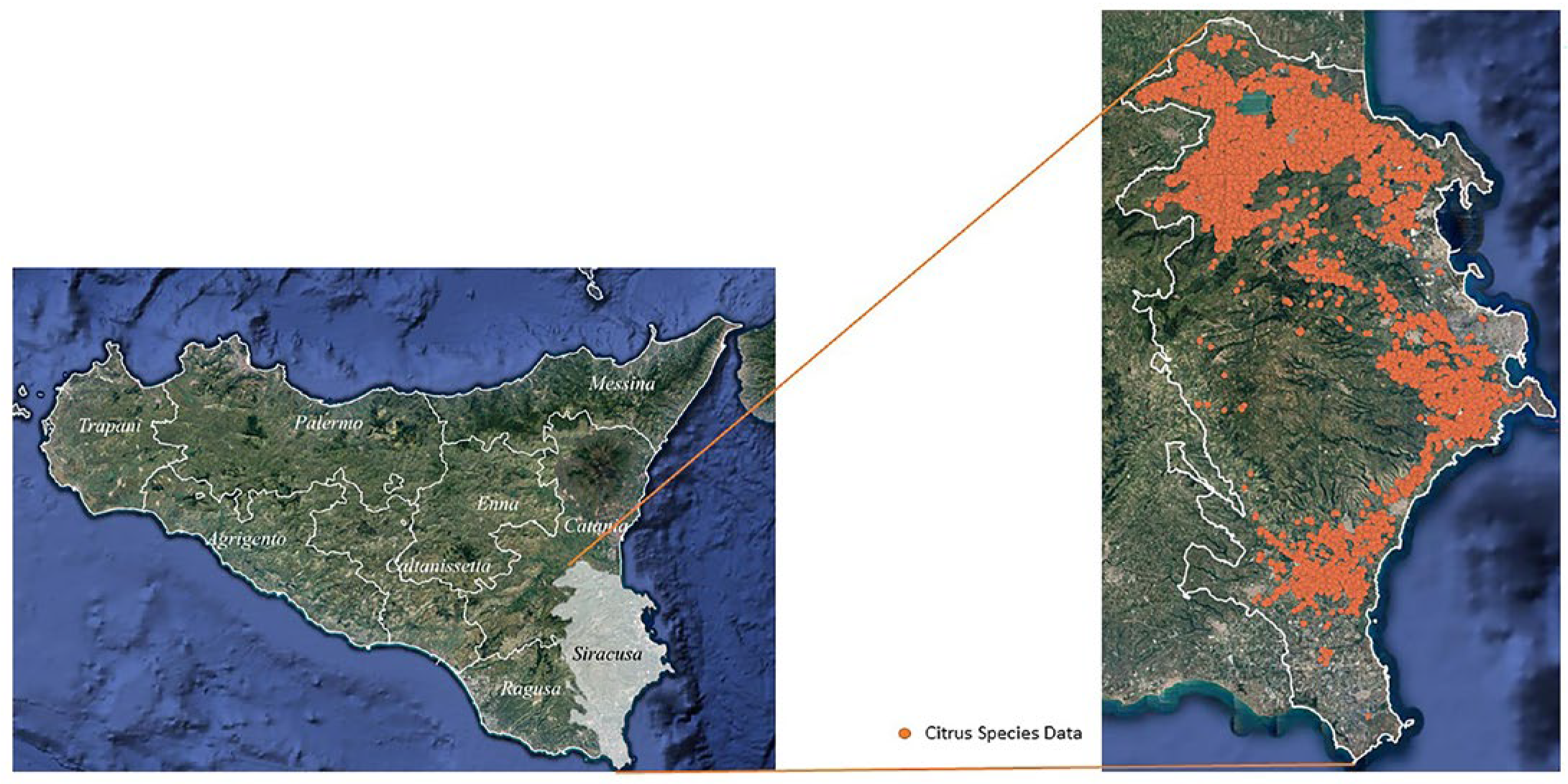
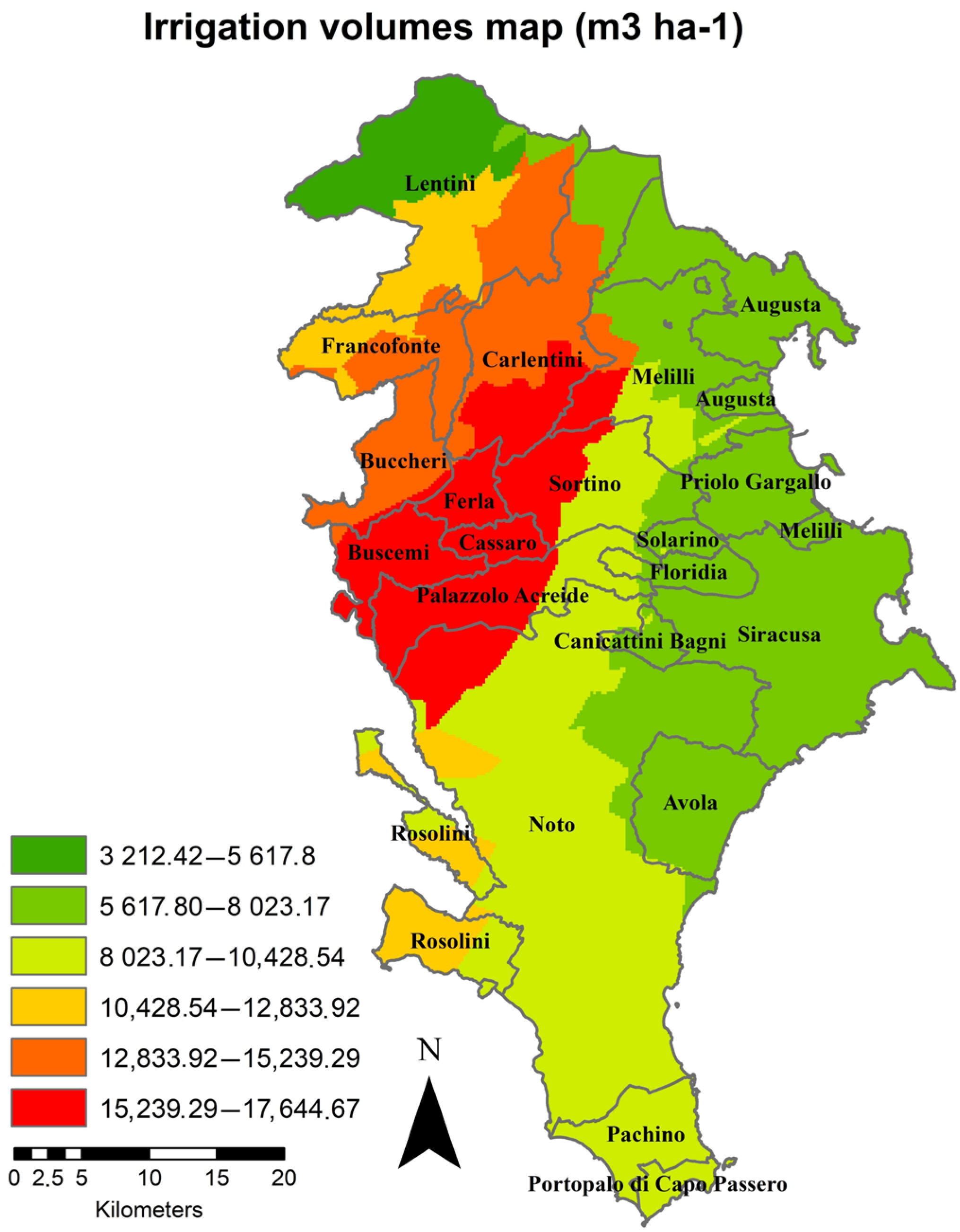
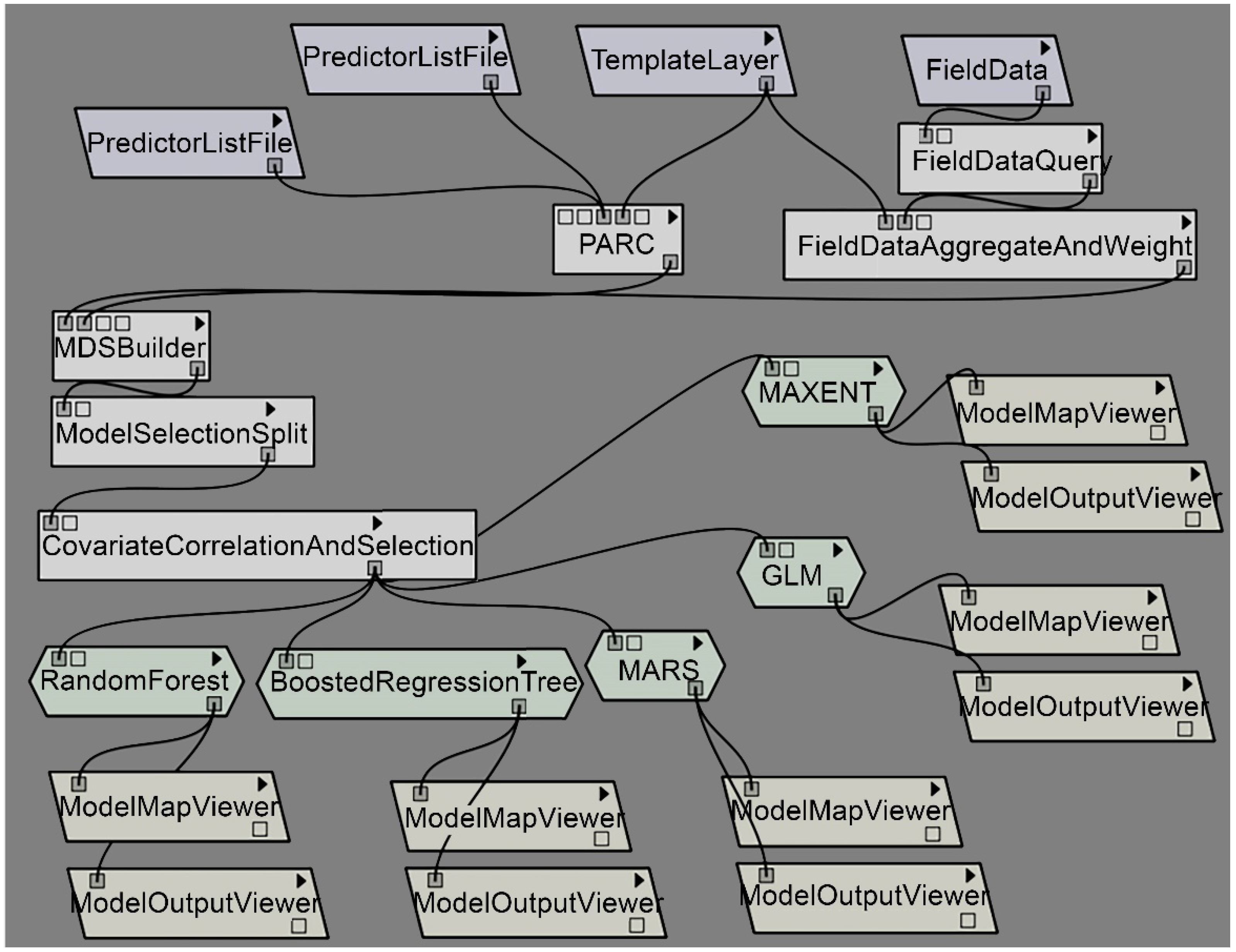
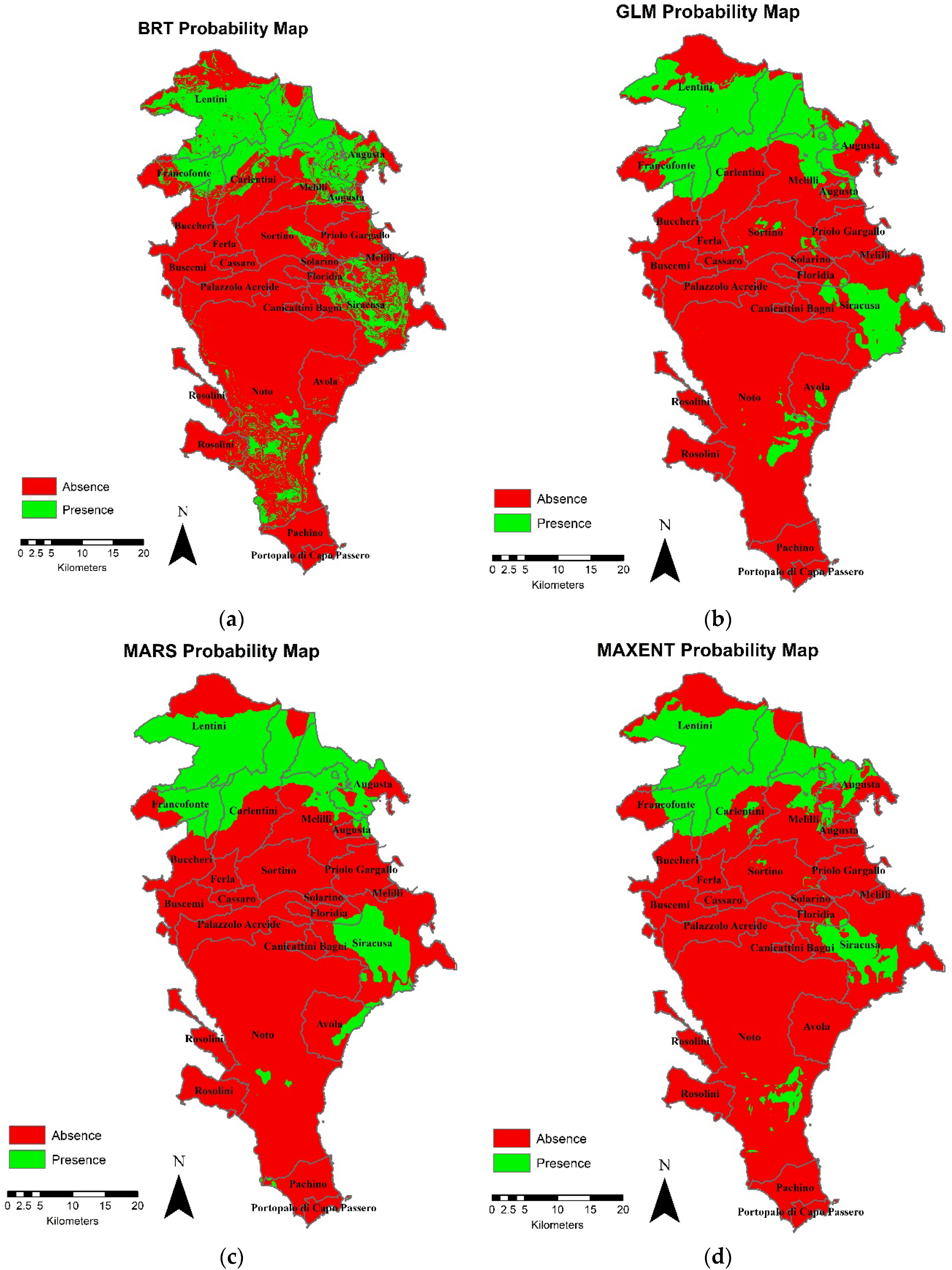

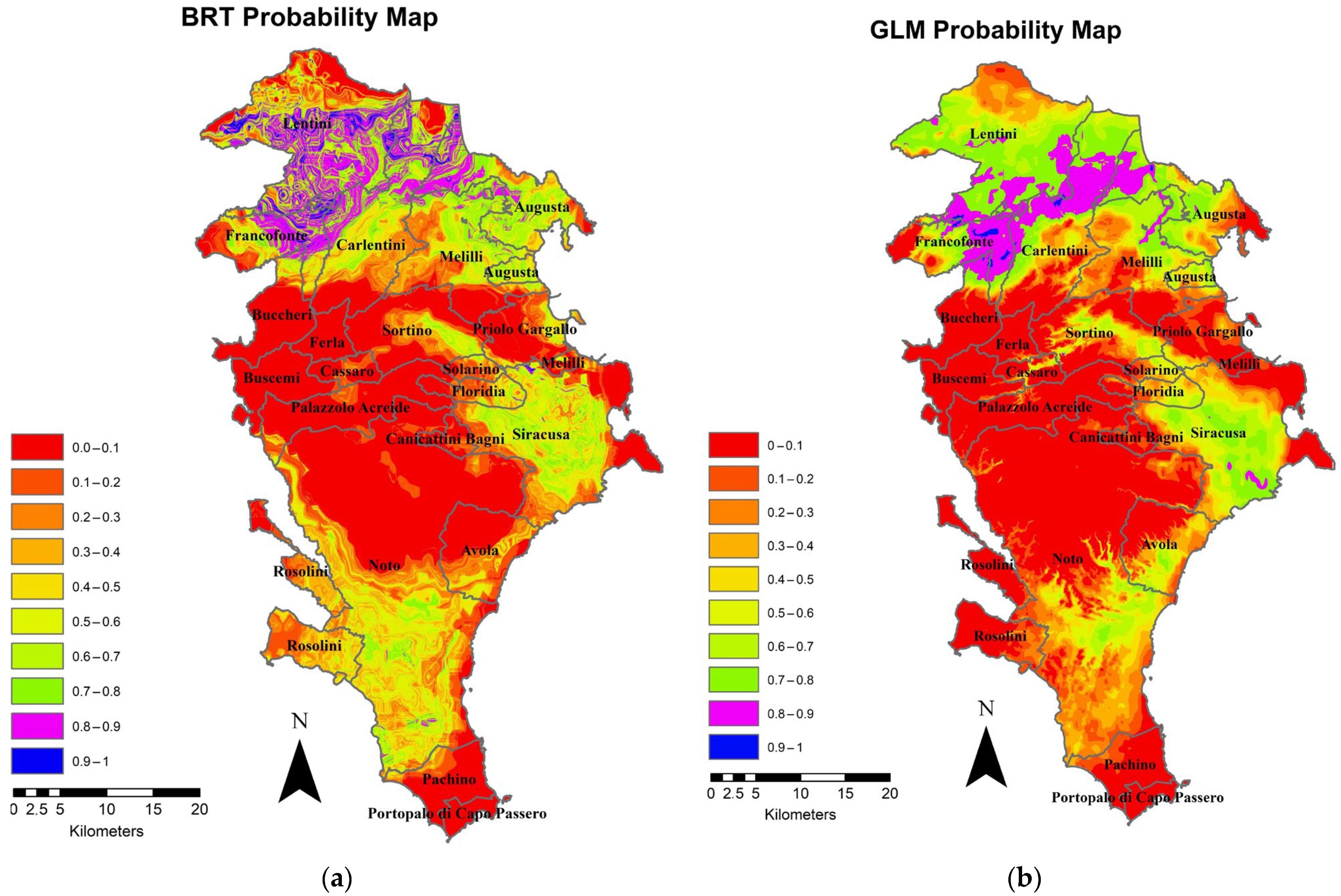

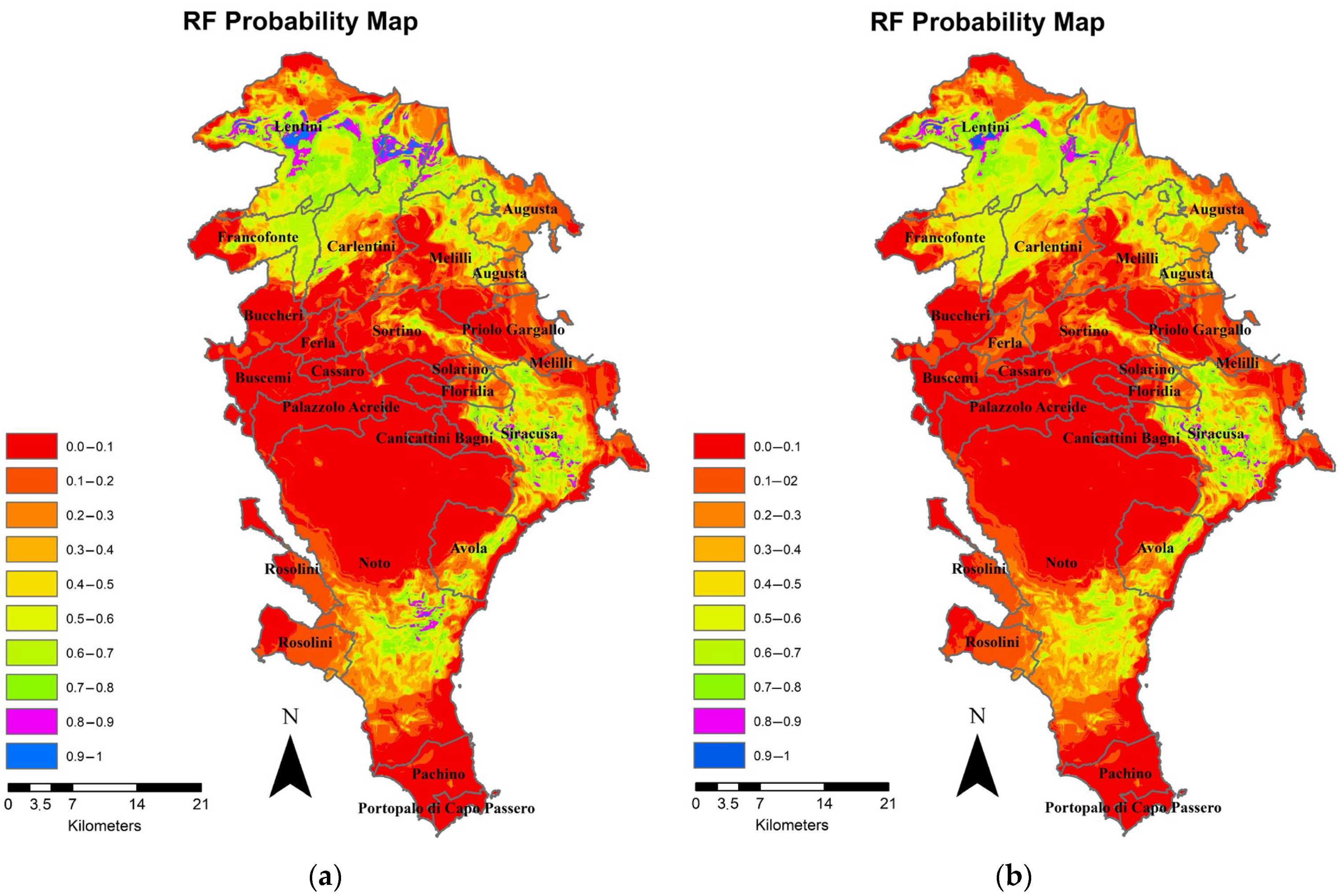
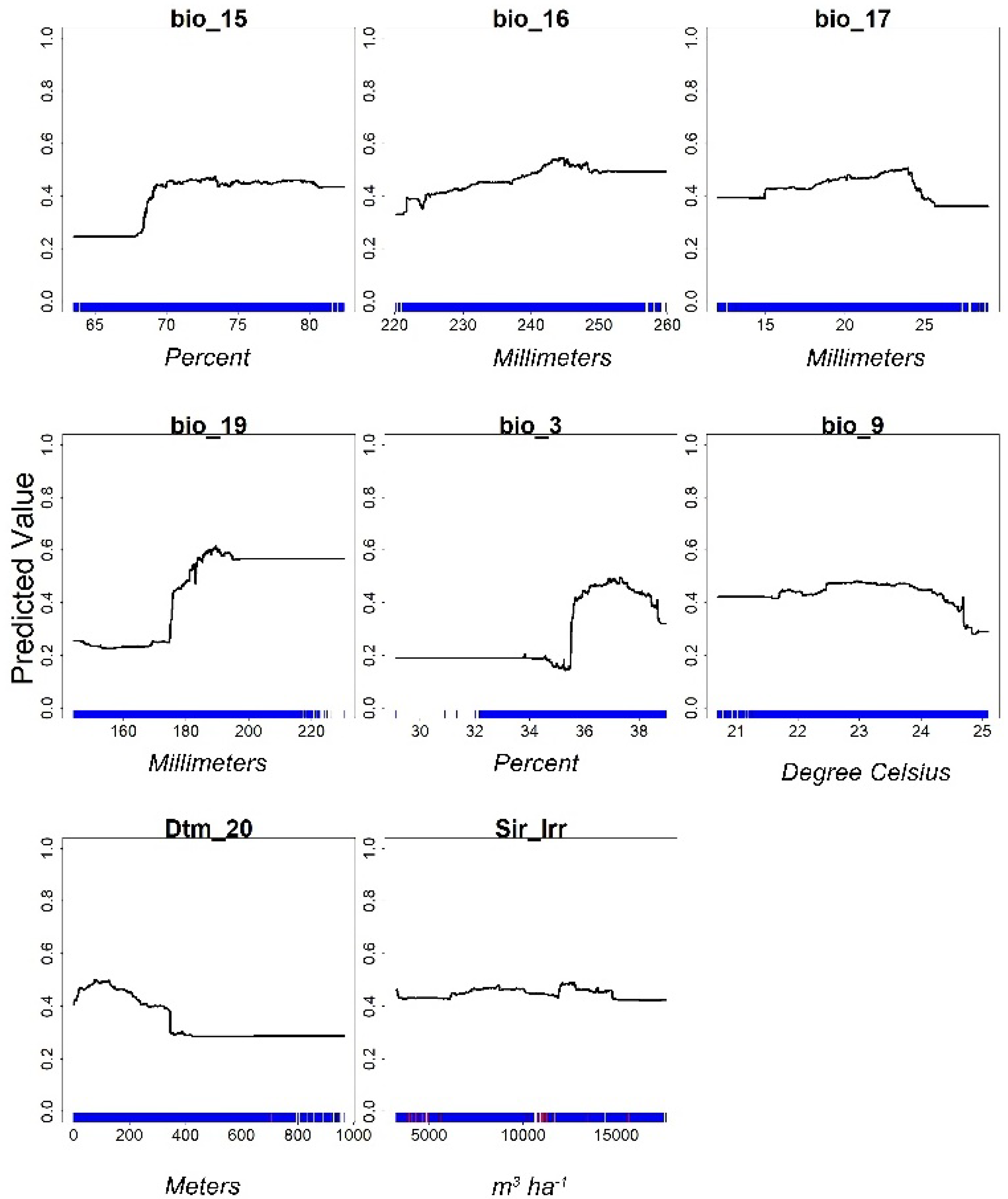
| Variables | Description | Unit of Measure |
|---|---|---|
| BIO1 | Annual Mean Temperature | Degrees Celsius |
| BIO2 | Mean Diurnal Range | Degrees Celsius |
| BIO3 | Isothermality | Percent |
| BIO4 | Temperature Seasonality | Temperature (degrees Celsius) |
| BIO5 | Max Temperature of Warmest Month | Degrees Celsius |
| BIO6 | Min Temperature of Coldest Month | Degrees Celsius |
| BIO7 | Temperature Annual Range | Degrees Celsius |
| BIO8 | Mean Temperature of Wettest Quarter | Degrees Celsius |
| BIO9 | Mean Temperature of Driest Quarter | Degrees Celsius |
| BIO10 | Mean Temperature of Warmest Quarter | Degrees Celsius |
| BIO11 | Mean Temperature of Coldest Quarter | Degrees Celsius |
| BIO12 | Annual Precipitation | Millimeters |
| BIO13 | Precipitation of Wettest Month | Millimeters |
| BIO14 | Precipitation of Driest Month | Millimeters |
| BIO15 | Precipitation Seasonality (Coefficient of Variation) | Percent |
| BIO16 | Precipitation of Wettest Quarter | Millimeters |
| BIO17 | Precipitation of Driest Quarter | Millimeters |
| BIO18 | Precipitation of Warmest Quarter | Millimeters |
| BIO19 | Precipitation of Coldest Quarter | Millimeters |
| Class | BRT | RF | MAXENT | GLM | MARS |
|---|---|---|---|---|---|
| 1 | 961.8 | 1178.5 | 688.7 | 826.0 | 715.9 |
| 2 | 187.9 | 175.3 | 197.3 | 189.6 | 210.9 |
| 3 | 140.3 | 111.2 | 235.4 | 175.0 | 173.4 |
| 4 | 133.3 | 84.5 | 278.4 | 163.9 | 191.8 |
| 5 | 125.4 | 79.8 | 315.5 | 120.1 | 232.2 |
| 6 | 115.6 | 80.3 | 385.4 | 130.1 | 136.1 |
| 7 | 122.50 | 82.3 | 2.2 | 176.6 | 122 |
| 8 | 147.90 | 88.1 | 0.0 | 190.4 | 152.8 |
| 9 | 153.40 | 106.8 | 0.0 | 127.1 | 164.3 |
| 10 | 21.00 | 116.1 | 0.0 | 4.3 | 3.6 |
| Model Metrics for Training | Model Metrics for Testing | |||||||||
|---|---|---|---|---|---|---|---|---|---|---|
| BRT | GLM | MARS | MAXENT | RF | BRT | GLM | MARS | MAXENT | RF | |
| AUC | 0.91 | 0.85 | 0.83 | 0.86 | 0.88 | 0.83 | 0.85 | 0.83 | 0.85 | 0.88 |
| PCC | 82.60 | 76.30 | 75.70 | 77.60 | 81.10 | 75.15 | 76.33 | 75.40 | 77.70 | 80.82 |
| TPR | 0.82 | 0.76 | 0.76 | 0.77 | 0.81 | 0.75 | 0.76 | 0.76 | 0.79 | 0.81 |
| TNR | 0.83 | 0.77 | 0.76 | 0.78 | 0.81 | 0.75 | 0.77 | 0.75 | 0.77 | 0.81 |
| TSS | 0.65 | 0.53 | 0.51 | 0.55 | 0.62 | 0.50 | 0.53 | 0.51 | 0.55 | 0.62 |
| BRT | GLM | MARS | MAXENT | RF | |
|---|---|---|---|---|---|
| ΔAUC | 0.0819 | 0.002 | −0.001 | 0.006 | 0 |
| ΔTSS | 0.148941 | −0.001 | 0 | −0.003 | 0.005 |
| Surface Areas Si [km2] for RF | ||||||||||
|---|---|---|---|---|---|---|---|---|---|---|
| Sir_Irr [%] | Class 1 (0–0.1) | Class 2 (0.1–0.2) | Class 3 (0.2–0.3) | Class 4 (0.3–0.4) | Class 5 (0.4–0.5) | Class 6 (0.5–0.6) | Class 7 (0.6–0.7) | Class 8 (0.7–0.8) | Class 9 (0.8–0.9) | Class 10 (0.9–1) |
| 100 | 1178.51 | 175.31 | 111.24 | 84.47 | 79.82 | 80.29 | 82.30 | 88.11 | 106.78 | 116.12 |
| 90 | 1037.24 | 258.91 | 135.18 | 114.69 | 110.68 | 128.96 | 133.06 | 104.70 | 62.56 | 17.00 |
| 80 | 938.60 | 297.99 | 173.17 | 132.91 | 126.14 | 150.23 | 146.69 | 90.47 | 37.56 | 9.20 |
| 70 | 897.24 | 323.55 | 190.02 | 136.93 | 126.88 | 151.10 | 148.63 | 88.85 | 33.04 | 6.73 |
| 60 | 878.25 | 338.28 | 195.36 | 145.18 | 130.22 | 159.13 | 147.59 | 75.55 | 29.10 | 4.30 |
| 50 | 873.12 | 347.13 | 191.05 | 147.93 | 142.12 | 181.72 | 130.23 | 66.01 | 20.48 | 3.18 |
| Dsup [%] | ||||||||||
|---|---|---|---|---|---|---|---|---|---|---|
| Sir_Irr [%] | Class 1 | Class 2 | Class 3 | Class 4 | Class 5 | Class 6 | Class 7 | Class 8 | Class 9 | Class 10 |
| 90 | −11.99 | 47.69 | 21.51 | 35.77 | 38.65 | 60.62 | 61.67 | 18.82 | −41.42 | −85.36 |
| 80 | −20.36 | 69.98 | 55.67 | 57.34 | 58.02 | 87.10 | 78.24 | 2.68 | −64.82 | −92.07 |
| 70 | −23.87 | 84.55 | 70.81 | 62.09 | 58.96 | 88.19 | 80.59 | 0.84 | −69.06 | −94.20 |
| 60 | −25.48 | 92.96 | 75.61 | 71.87 | 63.14 | 98.19 | 79.32 | −14.26 | −72.75 | −96.29 |
| 50 | −25.91 | 98.00 | 71.74 | 75.13 | 78.04 | 126.33 | 58.23 | −25.08 | −80.82 | −97.26 |
| Si/Stot [%] | ||||||||||
|---|---|---|---|---|---|---|---|---|---|---|
| Sir_Irr [%] | Class 1 | Class 2 | Class 3 | Class 4 | Class 5 | Class 6 | Class 7 | Class 8 | Class 9 | Class 10 |
| 100 | 55.88 | 8.31 | 5.27 | 4.01 | 3.78 | 3.81 | 3.90 | 4.18 | 5.06 | 5.51 |
| 90 | 49.18 | 12.28 | 6.41 | 5.44 | 5.25 | 6.11 | 6.31 | 4.96 | 2.97 | 0.81 |
| 80 | 49.18 | 12.28 | 6.41 | 5.44 | 5.25 | 6.11 | 6.31 | 4.96 | 2.97 | 0.44 |
| 70 | 44.50 | 14.13 | 8.21 | 6.30 | 5.98 | 7.12 | 6.96 | 4.29 | 1.78 | 0.32 |
| 60 | 42.54 | 15.34 | 9.01 | 6.49 | 6.02 | 7.16 | 7.05 | 4.21 | 1.57 | 0.20 |
| 50 | 41.40 | 16.46 | 9.06 | 7.01 | 6.74 | 8.62 | 6.17 | 3.13 | 0.97 | 0.15 |
Disclaimer/Publisher’s Note: The statements, opinions and data contained in all publications are solely those of the individual author(s) and contributor(s) and not of MDPI and/or the editor(s). MDPI and/or the editor(s) disclaim responsibility for any injury to people or property resulting from any ideas, methods, instructions or products referred to in the content. |
© 2023 by the authors. Licensee MDPI, Basel, Switzerland. This article is an open access article distributed under the terms and conditions of the Creative Commons Attribution (CC BY) license (https://creativecommons.org/licenses/by/4.0/).
Share and Cite
Catalano, G.A.; Maci, F.; D’Urso, P.R.; Arcidiacono, C. GIS and SDM-Based Methodology for Resource Optimisation: Feasibility Study for Citrus in Mediterranean Area. Agronomy 2023, 13, 549. https://doi.org/10.3390/agronomy13020549
Catalano GA, Maci F, D’Urso PR, Arcidiacono C. GIS and SDM-Based Methodology for Resource Optimisation: Feasibility Study for Citrus in Mediterranean Area. Agronomy. 2023; 13(2):549. https://doi.org/10.3390/agronomy13020549
Chicago/Turabian StyleCatalano, Giuseppe Antonio, Federico Maci, Provvidenza Rita D’Urso, and Claudia Arcidiacono. 2023. "GIS and SDM-Based Methodology for Resource Optimisation: Feasibility Study for Citrus in Mediterranean Area" Agronomy 13, no. 2: 549. https://doi.org/10.3390/agronomy13020549






